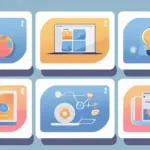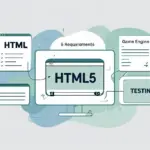Ever dreamed of building your own video game that runs right in a web browser—without needing to download anything? That’s the beauty of HTML5 games. They’re flexible, fast, and can reach millions of players worldwide. But what does it actually take to build one? Let’s break it down into the five must-have ingredients every aspiring HTML5 game developer needs to get started.
1. A Strong Understanding of HTML5, CSS3, and JavaScript
HTML5: The Core Structure
Think of HTML5 as the skeleton of your game. It’s the markup language that structures everything—your canvas, buttons, menus, and even where your game loads in the browser. If you’re new, don’t worry. HTML5 is quite beginner-friendly. But to make a game? You’ll need more than the basics. You’ll be using the <canvas> element heavily—it’s the place where all the game magic happens.
CSS3: Styling the Game World
Now imagine your game’s world without any design. It would be like a black-and-white coloring book. CSS3 steps in as your paintbrush. It’s used for animations, transitions, and UI styling like scoreboards and pop-ups. While most of the game animation is JavaScript-driven, CSS3 is great for smoother, lightweight effects that make your game pop.
JavaScript: Bringing It All to Life
Here’s where the real magic happens. JavaScript is the brain of your HTML5 game. Want to move a character, detect a collision, or keep score? That’s all JavaScript. Without it, your game would just be a pretty but lifeless scene. Mastering JavaScript is like learning the rules of your own universe—you’re the puppet master.
2. Game Engine or Framework
Why You Need a Game Engine
Building a game from scratch with raw JavaScript is doable… but painfully slow and complicated. That’s where game engines come in. They give you a head start with built-in functions for physics, asset loading, animations, and more.
Popular HTML5 Game Engines
Phaser
Phaser is like the Swiss Army knife for HTML5 game developers. It’s powerful, free, open-source, and beginner-friendly. It supports physics, audio, animation, and input right out of the box.
PixiJS
Need stunning 2D graphics and fast rendering? PixiJS is your best bet. While it’s not a full-blown game engine like Phaser, it shines when paired with your own custom game logic.
Construct
Don’t want to code? Construct is a drag-and-drop game builder for HTML5 that still allows deep customization. It’s perfect if you’re more into design than programming.
3. Graphics and Audio Assets
Where to Get Game Assets
You can’t have a game without visual and sound effects. Sites like OpenGameArt.org, kenney.nl, and itch.io offer free and premium-quality assets.
Creating Custom Assets
If you’re artistic, tools like Adobe Photoshop, Aseprite (for pixel art), and Audacity (for audio editing) help you build your own characters, tiles, and sound effects from scratch. Personalized assets can really set your game apart.
Optimizing for Performance
No one wants to play a laggy game. Compress your images, minimize file sizes, and use sprite sheets to load assets more efficiently. Use formats like .ogg or .mp3 for audio and .png or .webp for images.
4. A Reliable Code Editor and Development Tools
Choosing the Right Code Editor
Your code editor is your best friend. Most developers use Visual Studio Code because it’s lightweight, highly customizable, and has a ton of useful extensions like auto-complete, live server, and Git integration.
Using Browser DevTools
Every browser has built-in developer tools (DevTools) that let you debug JavaScript, inspect HTML elements, and monitor performance. Chrome DevTools, in particular, is extremely handy for real-time editing and testing.
Version Control with Git
Want to track your progress or collaborate with a team? Git is your safety net. You can save versions of your game, revert when something breaks, and work with others without stepping on each other’s code.
5. Testing and Deployment Environment
Testing Across Devices and Browsers
Your game might work great on your laptop but break on a smartphone. Always test your game across devices, screen sizes, and browsers. Tools like BrowserStack help simulate various environments.
Bug Fixing and Optimization
Debugging isn’t glamorous, but it’s critical. Test gameplay, fix broken mechanics, and track memory usage. Use JavaScript linters to clean your code and reduce unnecessary scripts.
Hosting and Deployment
Once your game is polished, it’s time to share it. You can use platforms like GitHub Pages for free hosting or go big with AWS, Netlify, or Firebase for more control and scalability. Just upload your game files, and boom—your game is live!
Bonus Tips for Aspiring HTML5 Game Developers
- Start Small: Your first game doesn’t have to be a masterpiece. Even a basic Pong clone will teach you a ton.
- Follow Tutorials: Sites like Mozilla Developer Network (MDN), freeCodeCamp, and Phaser’s own documentation are goldmines.
- Join Communities: Reddit’s r/gamedev and HTML5GameDevs.com are great places to ask questions, share progress, and get feedback.
- Keep Learning: Tech evolves fast. Stay sharp by building, failing, and learning from other developers’ games.
- Think Mobile-First: More than half of web gamers play on their phones. Make sure your game is responsive and touch-friendly.
Conclusion
Creating an HTML5 game isn’t as hard as it sounds—especially if you’ve got the right tools, mindset, and a dash of creativity. With a solid grasp of HTML5, CSS3, and JavaScript, a game engine by your side, and polished graphics and audio, you’re more than halfway there. Add a reliable code editor, some debugging magic, and a solid testing process, and you’ll be publishing your first browser game before you know it.
So what are you waiting for? Fire up your code editor, grab a cup of coffee, and let your game-building journey begin. Because if you can dream it—and code it—you can absolutely play it.



